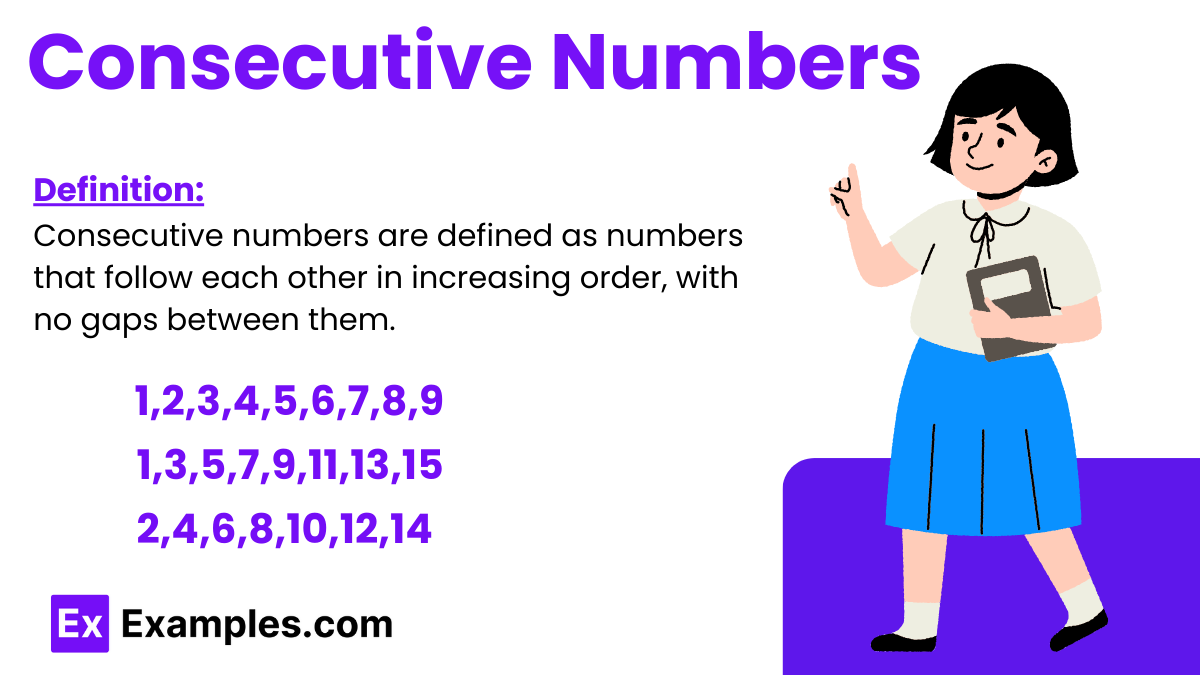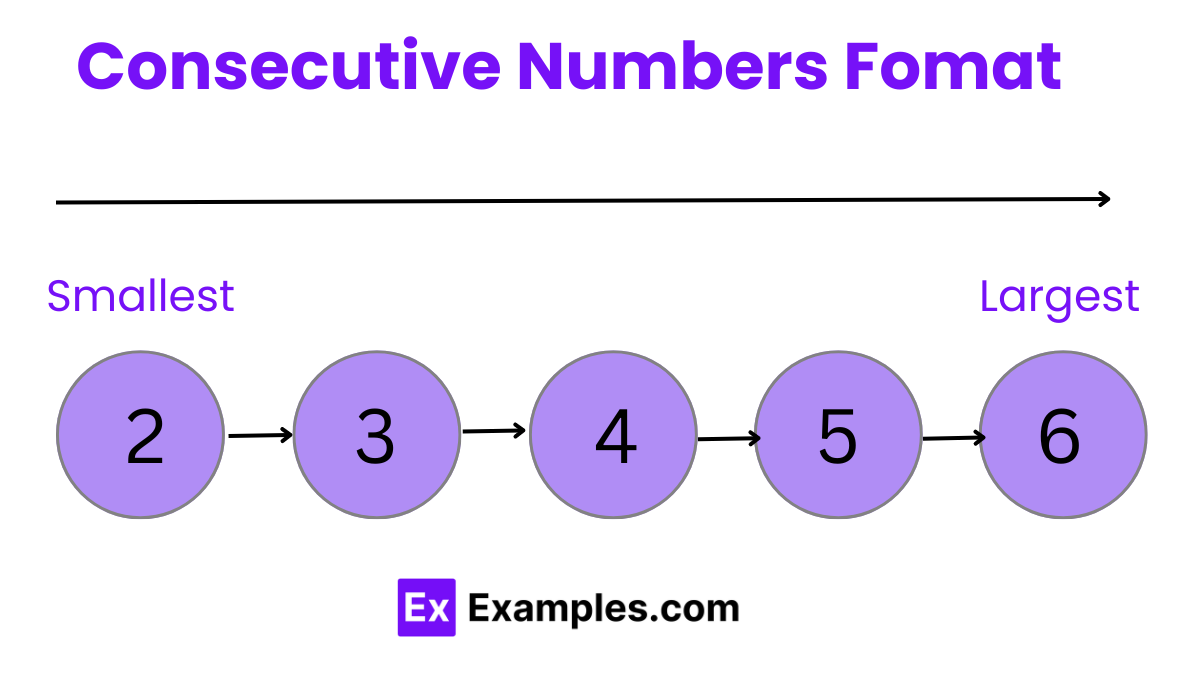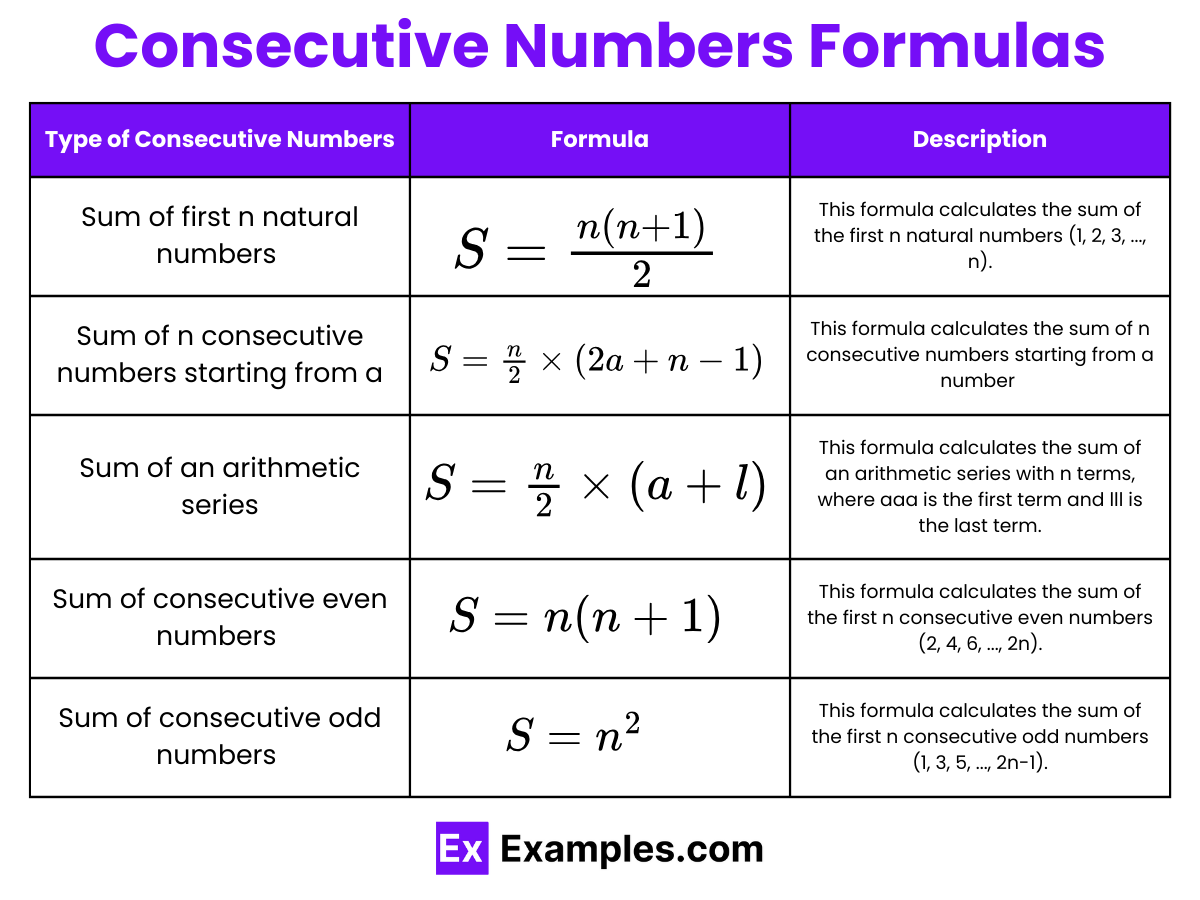The sum of three consecutive numbers is 27. What are the numbers?
8, 9, 10
9, 10, 11
10, 11, 12
11, 12, 13


Consecutive numbers are defined as numbers that follow each other in increasing order, with no gaps between them. The most common example of consecutive numbers is the sequence of counting numbers. For instance, the consecutive number after 1 is 2, and the consecutive number before 3 is 2.

Successor: A successor is a number that comes immediately after another number in a sequence. In mathematics, if you have a number n, its successor is n+1.
Predecessor: A predecessor is a number that comes immediately before another number in a sequence. In mathematics, if you have a number n, its predecessor is n−1.
Consecutive Even Numbers: Consecutive even numbers are even numbers that follow each other in order. The difference between each pair of consecutive even numbers is 2. For example, the sequence 2, 4, 6, 8 consists of consecutive even numbers.
To identify consecutive even numbers, start with any even number and keep adding 2 to find the next even number in the sequence.
If you want to find the n-th consecutive even number starting from a given even number aaa, you can use the formula:
n-th even number=a+2(n−1)
Example: To find the 5th consecutive even number starting from 6:
5th even number=6+2(5−1)=6+2×4=6+8=14
Consecutive odd numbers are odd numbers that follow each other in order. The difference between each pair of consecutive odd numbers is 2. For example, the sequence 1, 3, 5, 7 consists of consecutive odd numbers.
To identify consecutive odd numbers, start with any odd number and keep adding 2 to find the next odd number in the sequence.
If you want to find the n-th consecutive odd number starting from a given odd number aaa, you can use the formula:
n-th odd number=a+2(n−1)
Example: To find the 5th consecutive odd number starting from 7:
5th odd number=7+2(5−1)=7+2×4=7+8=15\text{5th odd number} = 7 + 2(5-1) = 7 + 2 \times 4 = 7 + 8 = 155th odd number=7+2(5−1)=7+2×4=7+8=15
Consecutive odd numbers appear in various real-life contexts:
Answer: 9, 11, 13, 15, 17, 19
Answer: 6th odd number=3+2(6−1)=3+2×5=3+10=13
Answer: -9, -7, -5, -3, -1, 1, 3, 5, 7, 9
Consecutive numbers are a sequence of numbers where each number is one more than the previous number. Understanding their properties helps in solving various mathematical problems efficiently. Here are some key properties:
Consecutive Numbers: A series of numbers where each number is one more than the previous number. For example, 3, 4, 5, 6 are consecutive numbers.





Consecutive numbers from 1 to 100 are numbers that follow each other in order without gaps. Starting from 1, they increase by 1 each time, ending at 100.
Three consecutive numbers are three numbers that follow one another in sequence. For example, 4, 5, and 6 are three consecutive numbers.
Five consecutive numbers are a sequence of five numbers that follow one another without gaps. For example, 11, 12, 13, 14, and 15 are five consecutive numbers.
The number 2334547 has no consecutive zeros. Consecutive zeros are two or more zeros in a row within a number.
No, 3 and 5 are not consecutive numbers. Consecutive numbers have a difference of 1 between each other, like 3 and 4.
No, 3, 5, and 7 are not consecutive numbers. They are part of an arithmetic sequence with a common difference of 2, but not consecutive.
No, 2 and 4 are not consecutive numbers. Consecutive numbers differ by 1, like 2 and 3 or 3 and 4.
The number 12 is not described as consecutive by itself. Consecutive refers to a sequence, such as 11, 12, and 13.
Yes, 3 and 2 are consecutive numbers. They follow each other in sequence with a difference of 1, regardless of the order.
Text prompt
Add Tone
10 Examples of Public speaking
20 Examples of Gas lighting
The sum of three consecutive numbers is 27. What are the numbers?
8, 9, 10
9, 10, 11
10, 11, 12
11, 12, 13
Find the product of the first two numbers in the sequence where the sum of four consecutive numbers is 34.
56
60
72
84
What is the smallest of four consecutive even numbers that sum up to 60?
12
14
16
18
The average of five consecutive integers is 20. What is the middle number?
18
19
20
21
If the sum of two consecutive odd numbers is 36, what is the first number?
15
17
18
19
What is the difference between the largest and smallest of five consecutive numbers that sum up to 75?
2
4
6
8
If the sum of three consecutive numbers is 45, what is the second number?
14
15
16
17
What are the three consecutive integers whose product is 720?
8, 9, 10
9, 10, 11
10, 11, 12
11, 12, 13
The difference between the first and third number in a sequence of four consecutive numbers is 6. What is the sum of these numbers?
24
25
26
27
What are the four consecutive integers that add up to 34?
7, 8, 9, 10
8, 9, 10, 11
9, 10, 11, 12
10, 11, 12, 13
Before you leave, take our quick quiz to enhance your learning!

